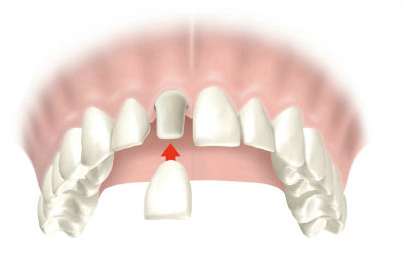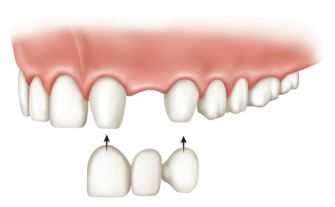Both crowns and most bridges are fixed prosthetic devices. Unlike removable devices such as dentures, which you can take out and clean daily, crowns and bridges are cemented onto existing teeth or implants, and can only be removed by the dentist.
|
How do Crowns Work?
A crown is used to entirely cover a damaged tooth. Besides strengthening a damaged tooth, a crown can be used to improve its appearance, shape or alignment. A crown can also be placed on top of an implant to provide a tooth-like shape. Porcelain and ceramic crowns can be matched to the color of your natural teeth. Other materials that can be used include gold and metal alloys. These alloys are generally stronger than porcelain and may be recommended for back teeth. |
Your dentist may recommend a crown to:
- Replace a large filling when there isn't enough tooth structure remaining
- Protect a weak tooth from fracturing
- Restore a fractured tooth
- Cover a dental implant
- Cover a discolored or poorly shaped tooth
- Cover a tooth that has had root canal treatment
|
How do Bridges Work?
A bridge may be recommended if you're missing one or more teeth. Gaps left by a missing teeth eventually cause the remaining teeth to rotate or shift into the empty spaces, resulting in an improper bite. This imbalance caused by missing teeth can also lead to gum disease and temporomandibular joint (TMJ) disorders. |
A bridge spans the space where the teeth are missing. Bridges are cemented to the natural teeth or implants surrounding the empty space. These teeth, called abutments, serve as anchors for the bridge. As with crowns, you have a choice of materials for bridges. The dentist can help you decide which to use, based on the location of the missing teeth, its function, aesthetic considerations and cost.
How are Crowns and Bridges Made?
Before either a crown or a bridge can be made, the teeth being treated must be reduced in size so that the crown or bridge will fit over it properly. After reducing the teeth, the dentist will take an impression and send it to our lab for custom fabrication. If porcelain is to be used, the dentist will determine the correct shade for the crown or bridge to match the color of your existing teeth. In the meantime, a temporary crown/bridge is cemented while the permanent crown/bridge is being made. When the permanent restoration is ready to be inserted, the temporary restoration is removed by the dentist.
Before either a crown or a bridge can be made, the teeth being treated must be reduced in size so that the crown or bridge will fit over it properly. After reducing the teeth, the dentist will take an impression and send it to our lab for custom fabrication. If porcelain is to be used, the dentist will determine the correct shade for the crown or bridge to match the color of your existing teeth. In the meantime, a temporary crown/bridge is cemented while the permanent crown/bridge is being made. When the permanent restoration is ready to be inserted, the temporary restoration is removed by the dentist.
How Long do Crowns and Bridges Last?
While crowns and bridges can last a lifetime, they do sometimes come loose or fall out. The most important step you can take to ensure the longevity of your crown or bridge is to practice good oral hygiene. A bridge can lose its support if the teeth or bone holding it in place are damaged by disease. Keep your gums and teeth healthy at home and be sure to see the dentist regularly for checkups and professional cleanings.
While crowns and bridges can last a lifetime, they do sometimes come loose or fall out. The most important step you can take to ensure the longevity of your crown or bridge is to practice good oral hygiene. A bridge can lose its support if the teeth or bone holding it in place are damaged by disease. Keep your gums and teeth healthy at home and be sure to see the dentist regularly for checkups and professional cleanings.



